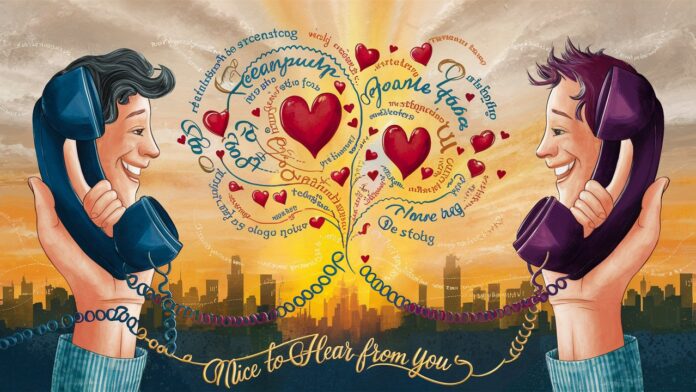Introduction
In a world dominated by fleeting digital exchanges, the phrase “Nice to hear from you“ carries surprising weight. Whether reconnecting with an old friend, responding to a colleague, or acknowledging a loved one, these six words can transform a routine interaction into a moment of genuine connection. But what makes this expression so impactful? This article explores the psychology, applications, and nuances of using “Nice to hear from you” to foster stronger relationships, both personally and professionally. We’ll delve into its emotional resonance, practical use cases, and even address common questions about its role in modern communication.
1. The Psychology Behind “Nice to Hear From You”
The phrase “Nice to hear from you” taps into a fundamental human need: validation. When someone acknowledges your outreach with warmth, it signals that your presence matters. Psychologically, this creates a sense of belonging and reduces feelings of isolation. Studies in interpersonal communication highlight that expressions of appreciation activate the brain’s reward centers, fostering trust and reciprocity. By saying “Nice to hear from you”, you’re not just being polite—you’re affirming the other person’s value in your life. This subtle act of recognition can lower emotional barriers, paving the way for deeper conversations and more authentic relationships.
2. Strengthening Personal Relationships Through Intentional Language
In personal relationships, “Nice to hear from you“ serves as a bridge between routine check-ins and heartfelt dialogue. Imagine a long-lost friend reaching out after years of silence. Responding with this phrase immediately conveys joy and openness, setting a positive tone for reconnection. For family members or partners, using it during stressful times (e.g., “It’s nice to hear from you—how are you holding up?”) demonstrates empathy and availability. However, its power lies in sincerity. Overusing it without follow-up questions or active listening can make it feel robotic. Pair the phrase with specific acknowledgments, like “I’ve missed our conversations” or “Your timing is perfect—I was just thinking about you,” to deepen its impact.
3. Enhancing Professional Relationships with Strategic Communication
In professional settings, “Nice to hear from you” balances professionalism with approachability. When a client or colleague initiates contact, this response acknowledges their effort while reinforcing mutual respect. For example, after receiving a project update, replying with “Nice to hear from you—thanks for keeping me in the loop” validates their work and encourages future collaboration. In networking, using the phrase after reconnecting with a contact (“It’s nice to hear from you! How can I support your current goals?”) positions you as a collaborative partner rather than a transactional connection. The key is to tailor the phrase to the context—avoid overly casual language in formal emails but maintain warmth to humanize corporate interactions.
4. The Role of Tone and Timing in Maximizing Impact
The effectiveness of “Nice to hear from you” hinges on tone and timing. In verbal conversations, a cheerful inflection conveys enthusiasm, while a softer tone might express concern during difficult moments. Written communication requires extra care—punctuation and context clues matter. An exclamation mark (“Nice to hear from you!”) feels energetic, ideal for congratulatory messages, whereas a period (“Nice to hear from you.”) might seem detached. Timing also plays a role: delaying a response for hours or days can dilute the phrase’s sincerity. Aim to reply promptly, even if briefly, to show the interaction is a priority.
5. Navigating Digital Communication: When “Nice to Hear From You” Fits
Digital platforms often prioritize brevity, but “Nice to hear from you” can counteract the impersonality of texts or emails. On social media, commenting this on a friend’s post (“Nice to hear from you—let’s catch up soon!”) rekindles connections without pressure. In email threads, using it as an opener (“Nice to hear from you! Let’s discuss next steps”) maintains professionalism while building rapport. However, avoid over-reliance in transactional exchanges (e.g., customer service queries), where efficiency trumps emotional nuance. Instead, reserve it for interactions where relationship-building is a goal.
Frequently Asked Questions (FAQs)
Q1: Are there alternatives to “Nice to hear from you” that convey similar warmth?
Yes! Phrases like “Great to connect!” or “Thanks for reaching out—I appreciate it” work well. Tailor alternatives to the relationship; for close bonds, “I’ve been looking forward to your message” adds personal flair.
Q2: Can “Nice to hear from you” ever backfire?
If used insincerely or excessively, it may feel disingenuous. Ensure your follow-up actions (e.g., listening, offering help) align with the sentiment.
Q3: How does culture influence the interpretation of this phrase?
In some cultures, direct expressions of emotion are less common. Research norms or mirror the recipient’s communication style to avoid misunderstandings.
Q4: Is it appropriate in formal written communication?
Yes, but pair it with professional language. For example, “Thank you for your email—it’s nice to hear from you. Regarding your inquiry…”
Q5: How often should I use this phrase?
Moderation is key. Reserve it for moments where acknowledgment strengthens the relationship, rather than in every exchange.
Conclusion
The simplicity of “Nice to hear from you“ belies its profound ability to nurture connections. By understanding its psychological roots, adapting it to personal and professional contexts, and prioritizing sincerity, this phrase becomes more than a courtesy—it becomes a tool for fostering trust, empathy, and lasting relationships. In an era where communication is often reduced to emojis and acronyms, taking the time to say “Nice to hear from you” reminds others they’re valued. So, the next time someone reaches out, consider how those six words might transform a mundane interaction into something meaningful. After all, isn’t that what connection is all about?


